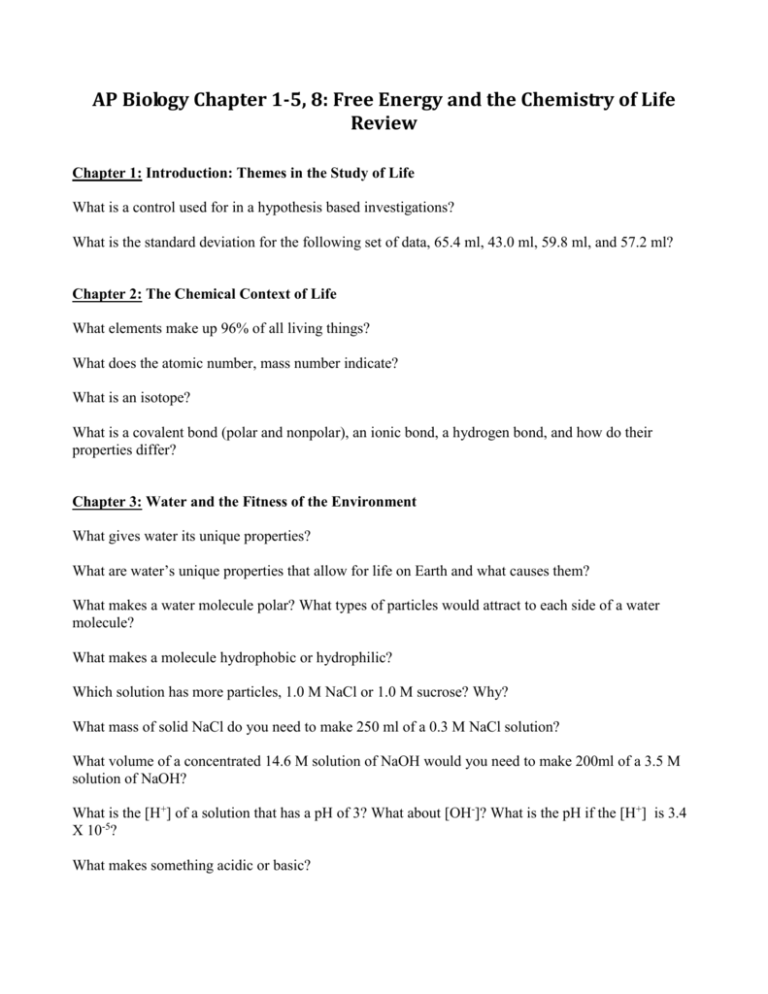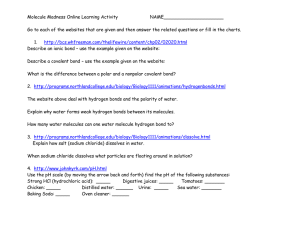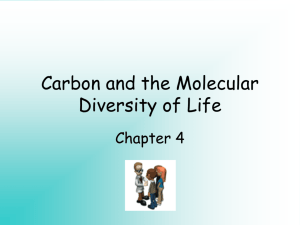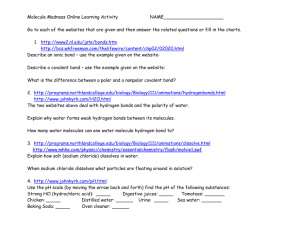AP Biology Chapter 1-5: Chemistry of Life Review
advertisement

AP Biology Chapter 1-5, 8: Free Energy and the Chemistry of Life Review Chapter 1: Introduction: Themes in the Study of Life What is a control used for in a hypothesis based investigations? What is the standard deviation for the following set of data, 65.4 ml, 43.0 ml, 59.8 ml, and 57.2 ml? Chapter 2: The Chemical Context of Life What elements make up 96% of all living things? What does the atomic number, mass number indicate? What is an isotope? What is a covalent bond (polar and nonpolar), an ionic bond, a hydrogen bond, and how do their properties differ? Chapter 3: Water and the Fitness of the Environment What gives water its unique properties? What are water’s unique properties that allow for life on Earth and what causes them? What makes a water molecule polar? What types of particles would attract to each side of a water molecule? What makes a molecule hydrophobic or hydrophilic? Which solution has more particles, 1.0 M NaCl or 1.0 M sucrose? Why? What mass of solid NaCl do you need to make 250 ml of a 0.3 M NaCl solution? What volume of a concentrated 14.6 M solution of NaOH would you need to make 200ml of a 3.5 M solution of NaOH? What is the [H+] of a solution that has a pH of 3? What about [OH-]? What is the pH if the [H+] is 3.4 X 10-5? What makes something acidic or basic? Chapter 4: Carbon and the Molecular Diversity of Life How many electron pairs does carbon share in order to complete its valence shell? What are the most important functional groups that make of the molecules of life? What are they made of and what do they look like? Chapter 5: The Structure and Function of Large Biological Molecules How do monomers of each of the different types of macromolecules become polymers? How many water molecules are needed to hydrolyze a polymer with 5 monomers? What are some examples of monosaccharides and polysaccharides? The molecular formula for glucose is C6H12O6. What would be the molecular formula for a molecule made by linking five glucose molecules together by dehydration reactions? What makes a monosaccharide and what do they look like? What is formed between more than one of them through dehydration? What makes up a lipid and what do they look like? What are the differences between and saturated and unsaturated fat? What are the different types of lipids and how are they different? What makes up a protein and what do they look like? What bonds the parts together? What is an enzyme? What makes up a nucleic acid and what do they look like? What is a nucleotide made of? What’s the difference between DNA and RNA? What are the 15 different molecules on the next page? How do the link up? Which ones link to form what type of macromolecule? What are some properties of those macromolecules? Chapter 8: An Introduction to Metabolism What is the difference between anabolic and catabolic pathways? What are free energy (G), enthalpy (H) and entropy (S)? and how are they affected in the above pathways? What is the difference between exergonic and endergonic reactions? Determine ΔG, ΔH and ΔS for different situations for example Which of the following shows the correct changes in thermodynamic properties for a chemical reaction in which amino acids are linked to form a protein? A) +△H, +△S, +△G B) +△H, -△S, -△G C) +△H, -△S, +△G D) -△H, -△S, +△G E) △H, +△S, +△G Is the above reaction endergonic or exergonic? What do each of the letters represent? What is an ATP made of? What other molecule is most similar in structure to ATP? How can you increase the rate of a reaction? Do enzymes affect the change in free energy, enthalpy or entropy of a reaction? How do competitive and noncompetitive inhibitors work? Be able to analyze a graph of data about enzymes to make a concluding statement. What are the different parts of the diagram below? A D C B *Review the AP Free Response Questions that are posted on the website after each lab we did and on water’s properties.











